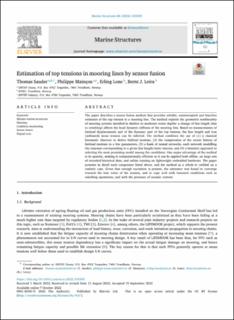Estimation of top tensions in mooring lines by sensor fusion
Peer reviewed, Journal article
Published version
Permanent lenke
https://hdl.handle.net/11250/3031795Utgivelsesdato
2022Metadata
Vis full innførselSamlinger
- Publikasjoner fra CRIStin - SINTEF AS [5802]
- SINTEF Industri [1566]
- SINTEF Ocean [1443]
Sammendrag
The paper describes a sensor fusion method that provides reliable, uninterrupted and bias-free estimates of the top tension in a mooring line. The method exploits the geometric nonlinearity of mooring systems installed in shallow to moderate water depths: a change of line length (due to winching) affects the local dynamic stiffness of the mooring line. Based on measurements of fairlead displacements and of the dynamic part of the top tension, the line length and true (unbiased) mean tension can be inferred. The method combines the use of (1) a classical kinematic observer to derive fairlead motions, (2) the compression of the recent history of fairlead motions to a few parameters, (3) a bank of neural networks, each network modelling the response corresponding to a given line length/static tension, and (4) a heuristic approach to selecting the most promising model among the candidates. One major advantage of the method is its sparsity, making it computationally efficient so it can be applied both offline, on large sets of recorded historical data, and online running on lightweight embedded hardware. The paper presents in detail each component listed above, and the method as a whole is verified on a realistic case. Given that enough excitation is present, the estimator was found to converge towards the true value of the tension, and to cope well with transient conditions such as winching operations, and with the presence of oceanic current.

